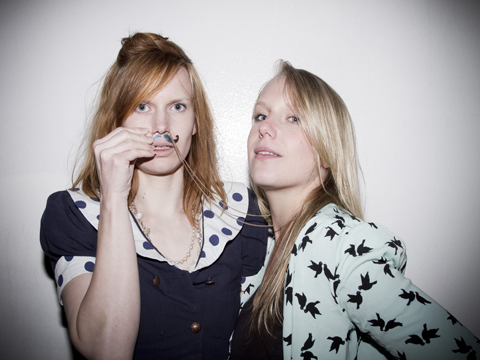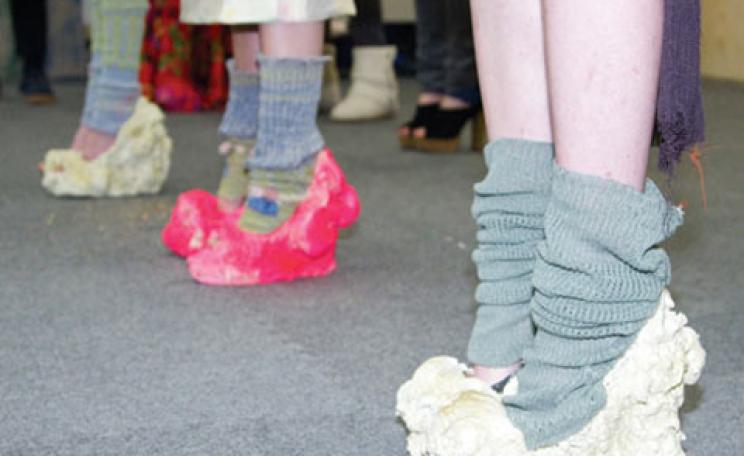She might not have the instant name recognition enjoyed by Livia Firth but Orsola de Castro has done as much, if not more, than the queen of the green carpet, to raise the profile of the UK’s eco designers. What’s more, as the brains behind the British Fashion Council’s Estethica initiative, she’s helped champion young green design talent, all while working on her own label, From Somewhere. But de Castro’s work doesn’t stop there. From Somewhere is known for its collaborations, most famously with Tesco (when the label created a dress made from pre-consumer waste for the supermarket’s Florence and Fred brand) but more recently with swimwear giant, Speedo. Now, de Castro has launched Reclaim to Wear, which she describes as ‘the collaborative arm of my label’ which has just started working with up and coming Central St Martins talent following a successful collection designed with Livia Firth. So is this the future of eco design in action?
‘We [Reclaim to Wear] started with a series of collaborations and Central Saint Martins is the first that we're doing within education,’ says de Castro, in her Italian accented English. ‘It has proved so successful that we're hoping to make it an annual appointment for Estethica. Reclaim to Wear is really a way of showing our knowledge and taking it to another level and to as many people as possible, whether it's to students, the high street, established designers, young designers, and so to do it with Central Saint Martins as part of their autumn theme project was an incredible opportunity for us and the creativity has been amazing. The results are wonderful.’ Like de Castro’s From Somewhere label, Reclaim to Wear works mostly with pre-consumer waste, or to put it in layman’s terms, leftover textile offcuts. I wonder how sustainable upcycling really is for a label, because, surely, if you work with offcuts, you lose consistency, which can be a real issue for the consumer. Not surprisingly, de Castro doesn’t agree, and says that it can work – no matter what sort of scale you’re dealing with.
 ‘No, that's not true, that's not true,’ she exclaims, getting slightly agitated. ‘Unfortunately this is still embargoed but we are doing a Reclaim to Wear project with a giant of the high street and that will use a completely different principle. It depends on what you're working with. I mean if you're working with liability stock you can achieve any amounts of reproduce-ability. The collection that we did with Livia Firth (launched under the Reclaim to Wear banner and sold on Yoox.com) that was also fully reproducible. So it's a designer choice whether you want to make it reproducible or unique, and entirely [depends] on where you're going to sell it. So, as I said, it's perfectly commercial. It makes a lot of sense. It saves a lot of money as well as water and energy to have good housekeeping in terms of your textile use. ‘
‘No, that's not true, that's not true,’ she exclaims, getting slightly agitated. ‘Unfortunately this is still embargoed but we are doing a Reclaim to Wear project with a giant of the high street and that will use a completely different principle. It depends on what you're working with. I mean if you're working with liability stock you can achieve any amounts of reproduce-ability. The collection that we did with Livia Firth (launched under the Reclaim to Wear banner and sold on Yoox.com) that was also fully reproducible. So it's a designer choice whether you want to make it reproducible or unique, and entirely [depends] on where you're going to sell it. So, as I said, it's perfectly commercial. It makes a lot of sense. It saves a lot of money as well as water and energy to have good housekeeping in terms of your textile use. ‘
‘So, then,’ I ask, ‘if it's cheaper and the quality is good, why don't more designers do it?’ ‘Because it's a question of signature. It's a little more time consuming and the cutting is different. But it's also very much of a signature and in the industry most young designers do it now. It's not rocket science, or it's not being done or it's forgotten, people have forgotten how to do it on a natural level. But it's only really in the last 25 years since over-consumption has created such a massive problem - the textile industry generally has operated a very successful system of recycling itself. Upcycling is a novelty; in the sense there is no chemical of other industrial intervention in terms of recycling and shredding and all of that. So upcycling is relatively new. And more and more people are doing it and more and more students want to learn in such schools, so as I said it's a relatively new technique that will become more and more commercially viable in the future.’
 De Castro has raised another interesting point: that of what’s in store for eco fashion over the next 20 years. Should it stay niche? Should green fashion become the mainstream? Is that even possible? And most importantly, are we seeing a real shift in consumer attitudes towards fashion, or is this just another trend? De Castro is optimistic. ‘I think particularly at a time like this when people just don't have the money to go and spend on an extra t-shirt, it becomes very interesting. People are thinking about the community price of what five t-shirts would have cost and [instead] are buying just one, which they know is the one that they want. So not only are people beginning to re-engage emotionally with what they're buying because they're buying better, they're buying because they want to rather than because they can, which is a very, very different attitude.’ This, she believes, will have positive results for the greener end of the fashion spectrum. ‘Upcycling is very powerful because it speaks - you will recognise something is upcycled - so it has the same value as a slogan t shirt in terms of what you actually want to say about yourself. It’s very intriguing to the younger generation - kids coming out of colleges are absolutely hell-bent in using upcycling as part of their collection. We're seeing that more and more in more and more colleges and young designers. And of course as you know, we have Christopher Raeburn, who is green and an upcycler, being named the Emerging Talent for Menswear at the 2011 British Fashion Awards. That has a profound impact on the way that young people see upcycling.’
De Castro has raised another interesting point: that of what’s in store for eco fashion over the next 20 years. Should it stay niche? Should green fashion become the mainstream? Is that even possible? And most importantly, are we seeing a real shift in consumer attitudes towards fashion, or is this just another trend? De Castro is optimistic. ‘I think particularly at a time like this when people just don't have the money to go and spend on an extra t-shirt, it becomes very interesting. People are thinking about the community price of what five t-shirts would have cost and [instead] are buying just one, which they know is the one that they want. So not only are people beginning to re-engage emotionally with what they're buying because they're buying better, they're buying because they want to rather than because they can, which is a very, very different attitude.’ This, she believes, will have positive results for the greener end of the fashion spectrum. ‘Upcycling is very powerful because it speaks - you will recognise something is upcycled - so it has the same value as a slogan t shirt in terms of what you actually want to say about yourself. It’s very intriguing to the younger generation - kids coming out of colleges are absolutely hell-bent in using upcycling as part of their collection. We're seeing that more and more in more and more colleges and young designers. And of course as you know, we have Christopher Raeburn, who is green and an upcycler, being named the Emerging Talent for Menswear at the 2011 British Fashion Awards. That has a profound impact on the way that young people see upcycling.’
Raeburn, whose career highlights include being the first designer to be awarded both men’s and womenswear NEWGEN sponsorship and winning the Ethical Fashion Forum’s INNOVATION competition in 2009, is at the forefront of the wave of green talent that has emerged over the last decade, and de Castro doesn’t see the flow abating any time soon. In part, of course, that’s down to her and the platform for green talent that Estethica has provided. So is she proud of what her initiative has achieved? ‘It [eco design] is very cool right now and I do believe that Estethica has very much changed the stakes in terms of eco-fashion, so I'm very proud and delighted to have been a part of this,’ she smiles.
‘I also believe that it is the responsibility of the industry to change and I am also very much a believer that the uncool, kind of hippy-dippy image of eco-fashion was on the way out before it started, because inevitably, you have to look at the full industry to see what fashion is. When Estethica started in 2006, it was a little bit Holland & Baratts circa 1989, and it was obvious that it was going to change.’ Obvious to who though? Wouldn't you say eco fashion still has a whiff of homespun about it as far as many consumers are concerned? According to de Castro, the homespun hemp perception of eco-fashion has been consigned to the history books. ‘I don't think the people in any way, shape or form associate it with hippy-dippy any longer,’ she argues. ‘I think it's much more cutting edge and I think it has earned its place in the fashion industry for good.’
| READ MORE... | |
 |
GREEN LIVING PHOTO GALLERY: Copenhagen Fashion Week Whether organic cotton, local wool or Scottish cashmere, textiles were all natural, with Danish designers proving that sustainability and style can mix, says Ruth Styles |
 |
GREEN LIVING The Ecologist meets... Copenhagen's The Baand In part one of our Copenhagen Fashion Week special, Ruth Styles talks sustainable style with Stine Bauer Boskov and Julie Villumsen – the brains behind hot Danish eco-brand, The Baand |
 |
GREEN LIVING Five of the best…organic cotton t-shirts Whether you’re taking up pilates or just going for a jog, there’s an fabulous eco-friendly t-shirt for you |
 |
GREEN LIVING Risqué business: how Holloway-Smith Noir is making burlesque fashionably green Eco-friendly smalls anyone? Green Living editor Ruth Styles meets the duo turning burlesque glamour into planet-pleasing nipple pasties |
 |
GREEN LIVING Patagonia: the anti-fashion fashion brand It's the 'Gucci of outdoor wear' but for founder, Yvon Chouinard, there's far more to Patagonia than fashion. He spoke to Matilda Lee |








